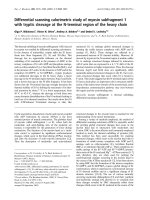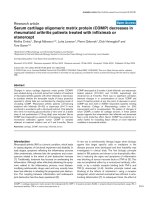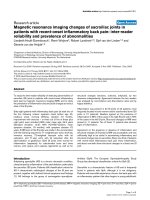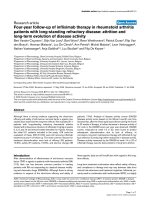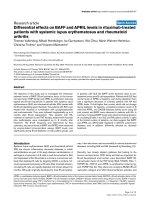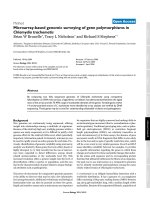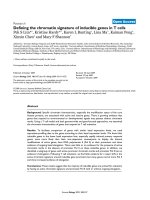Báo cáo y học: "An open pilot study of zonisamide augmentation in major depressive patients not responding to a low dose trial with duloxetine: preliminary results on tolerability and clinical effects" ppsx
Bạn đang xem bản rút gọn của tài liệu. Xem và tải ngay bản đầy đủ của tài liệu tại đây (297.23 KB, 8 trang )
PRIMARY RESEARCH Open Access
An open pilot study of zonisamide augmentation
in major depressive patients not responding to a
low dose trial with duloxetine: preliminary results
on tolerability and clinical effects
Michele Fornaro
1
, Matteo Martino
1*
, Bruna Dalmasso
2
, Salvatore Colicchio
3
, Marzia Benvenuti
4
, Giulio Rocchi
1
,
Andrea Escelsior
1
and Giulio Perugi
4
Abstract
Background: Despite multiple antidepressant options, major depressive disorder (MDD) still faces high non-
response rates, eventually requiring anticonvulsant augme ntation strategies too. The aim of this study was to
explore such a potential role for zonisamide.
Methods: A total of 40 MDD outpatients diagnosed using the Diagnostic and Statistical Manual for Mental
Disorders, fourth edition criteria entered a 24 week open trial receiving duloxetine 60 mg/day for the first 12 weeks
and subsequently (weeks 12 to 24) augmentation with zonisamide 75 mg/day if they did not respond to the initial
monotherapy. Efficacy and tolerability were assessed using the Hamilton Scales for Anxiety and Depression (a 12
week score ≥50% vs baseline defined ‘non-response’), the Arizona Sexual Experience Scale, the Patient Rated
Inventory of Side Effects and the Young Mania Rating Scale.
Results: At week 12, 15 patients out of 39 (38.5%) were responders, and 1 had dropped out; remarkably, 14
patients out of 24 (58.3%) had achieved response by week 24. Poor concentration and general malaise were
associated with non-response both at week 12 and 24 (P = 0.001), while loss of libido and reduced energy were
prominent among final timepoint non-responders. Patients receiving zonisamide also experienced weight
reduction (2.09 ± 12.14 kg; P = 0.001) independently of the outcome.
Conclusions: Although only a preliminary study due to strong methodological limitations, and thus requiring
confirmation by further controlled investigations, the current results indicate zonisamide may be a potential
augmentation option for some depressed patients receiving low doses of duloxetine.
Introduction
Major depressive disorder (MDD) is significant cause of
morbidity and mortality, and is associated with a high
socioeconomic burden [1]. Both pharmacological and
non-pharmacological intervent ions have proven efficacy
in many MDD cases, yet failure to respond to standard
interventions still represents a frequent scenario [2].
Among other issues, nosological boundaries and phar-
macological issues might lead to unfavorable outcomes,
prompting pharmacological augmentation strategies [3]
even for ‘ proven effective’ antidepressants such as the
serotonergic norepinephrinergic reuptake inhibitors
(SNRIs) [4].
A pharmacological augmentation strategy involves a
number of agents from different classes, including some
anticonvulsants routinely prescribed in the clinical set-
ting both for anxious states [5] and/or depression [6],
sometimes controversially [7,8]orevenintheabsence
of a bipolar course of illness [6].
To mention one, lamotrigine is an anticonvulsant drug
often used as an antidepressant augmentation therapy
even for non-bipolar patients, although its use as
* Correspondence:
1
Department of Neuroscience, Section of Psychiatry, University of Genova,
Genoa, Italy
Full list of author information is available at the end of the article
Fornaro et al. Annals of General Psychiatry 2011, 10:23
/>© 2011 Fornaro et a l; licensee BioMed Central Ltd. This is an Open Access article distributed under the terms of the Creative Commons
Attribution License (http://creativecommons.o rg/licenses/by/2.0), which permits unrestricted use, distribution, and reproduction in
any medium, provided the original work is properly cited.
augmentation strategy for treatment-resistant unipolar
depression is supported by only a single randomized clini-
cal trial [9]. While it may be argued that many Diagnostic
and Statistical Manual for Mental Disorders,fourthedi-
tion (DSM-IV) [10] cases of depression should indeed fol-
low a bipolar di athesis, suggesting prudent (or low dose)
prescription of antidepressants and/or augmentation
therapies with antimanic agents [2], such a prescribing
habit is a popular clinical practice also supported by phar-
macodynamic considerations. With regard to lamotrigine,
its actions include blockade of sodium and calcium chan-
nels, hypothetically leading to reduced N-methyl-D-aspar-
tate glutamatergic transmissio n as well as changes in the
activity of crucial neurotransmitters involved in the patho-
physiology of depression, including dopamine and seroto-
nin [11-13]. Therefore, in consideration of a partial
pharmacodynamic overlap between lamotrigine and the
latterly introduced zonisamide [14-16] (at least with regard
to a common putative modulation o f glutamate and
monoamines), and accounting for the drug concentration-
related biphasic effects of zonisamide on serotonergic sys-
tem functioning in rat hippocampus [15], zonisamide
should also receive attention for its potential role in the
management of some psychiatric disturbances, as recently
proposed for anxiety disorders refractory to standard
anxiolytic medications [17]. Additionally, zonisamide (a
sulfonate anticonvulsant drug with long half life (65 h in
plasma) approved for use as an adjunctive therapy in
adults with partial-o nset seizures, infantile spasm, mixed
seizure types of Lennox-Gastaut syndrome, myoclonic,
and generalized tonic clonic seizure), when added at 25 to
50 mg/day to commonly used anti-Parkinsonian drugs,
significantly improved the primary symptoms of patients
with advanced Parkinson’s disease, possibly by activatio n
of dopamine synthesis, inhibition of monoamine oxidase
type B, inhibition of T-type calcium channels and inhibi-
tion of an indirect pathway in the basal ganglia through
the sigma opioid receptor [18]. Therefore, zonisamide’ s
propensity to facilitate dopaminergic and serotonergic
release in vivo [19] might suggest an exploration of its
potential role as augmentation strategy for common anti-
depressant drug s is prudent, possibly even at dosages
lowe r than the ones usually adopted for the treatment of
epileptic conditions.
Therefore, in this study we explore the efficacy and
tolerability of adjunctive zonisamide in the treatment of
MDD not responsive to a preliminary trial of the SNRI
antidepressant duloxetine administered at low dose (60
mg/day).
Methods
Study design
This was a preliminary 24 week open trial designed to
asse ss the efficacy and tolerability of zonisamide 75 mg/
day augmentation for MDD patients (actually an off-
label prescription of zonisamide) not responding to a 12
week treatment with duloxetine at 60 mg/day. The unu-
sual choice of duloxetine was essentially dictated by
pharmacokinetic and pharmacodynamic issues, in view
of subsequent combination with zonisamide. The study
was conducted from February 2008 to September 2010,
with approval by the Ethical Committee of the San Mar-
tino Hospital, University of Genova, Genoa, Italy in
November 2007.
Subjects
The planned and actual study population included 40
outpatients, aged 18 years or older, of both genders, ful-
filling DSM-IV crite ria for MDD and with a current sin-
gle or recurrent major depre ssive episode. At s creening,
patients had to have a mini mum score of 18 on the 17-
item Hamilton Scale for Depression (HAM-D) [20].
Exclusion criteria included the following DSM-IV-
defined diagnoses: bipolar disorders (either type I or
type II), cyclothymia, schizoaffective disorder or schizo-
phrenia, dementia or substance abuse disorder in the
last 6 months, suicidal ideation that made pa rticipa tion
unduly risky, unstable medical conditions, abnormal
thyroid function, QTc ≥450 ms on screening electrocar-
diogram (ECG; calculated using the Bazett formula),
being pregnant, lactating, or not using adequate contra-
ception if capable of getting pregnant, as well as having
known contraindications for zonisamide (for example,
history of severe myopia, kidney stones or narrow angle
glaucoma) or duloxetine. Patients were also excluded if
unwilling or unable to provide valid signed informed
consent or if they could not safely taper concomitant
psychotropic drugs, which had to b e withdrawn for 2
weeks, except for fluoxetine and depot neuroleptics
requiring at least a 4 week discontinuation. Zolpidem 10
mg at bedtime was allowed, but could not be taken the
night before scheduled assessments. Finally, body weight
(in kg) was also recorded at screening, week 12 (main
evaluation time) and week 24 (endpoint) along with
repeated medical monitoring including ECG recording.
Patients could leave the study at any time and still
obtain clinical care.
Study procedures and efficacy measures
Diagnosesweremadebyclinicalexaminationandthe
Structured Clinical Interview for DSM-IV Axis-I Disor-
ders/Patient Edition (SCID-I/P) [21]. At baseline, eligible
patients started taking duloxe tine 60 mg/day once a day
after being evaluated by means of the HAM-D, Hamil-
ton Scale for Anxiety (HAM-A) [22], Young Mania Rat-
ing Scale (YMRS) [23] and the Arizona Sexual
Experience Scale (ASEX) [24]. All measurements were
repeated at week 12 and week 24 while the Patient
Fornaro et al. Annals of General Psychiatry 2011, 10:23
/>Page 2 of 8
Rated Inventory of Side Effects (PRISE) [25] was admi-
nistered at week 12 and week 24 as primary tolerability
evaluation. As major outcome measurement, a week 12
HAM-D total score ≤50% vs baseline defined ‘non-
response’ . Similarly, an endpoint H AM-D total score
≤50% vs baseline was adopted to define (final) ‘ respon-
ders’ (primary endpoint) or ‘remission’ if < 7.
Data analysis
Both descriptive and analytical analyses (c
2
or t tests
when appropriate) were performed using SPSS V.19 for
Windows (SPSS, Chicago, IL, USA). Two-tailed tests
with a 5% level of significance were used through the
analyses. Since the data followed a normal distribution
(assessed by Kolmogorov-Smirnov test), only parametric
analyses were conducted. Finally, as a result of the very
low numb er of dropout cases (in fact, n = 1; see below)
an intent to treat analysis was performed.
Results
A total of 40 patients, all of Caucasian origin, consti-
tuted the study sample. Two patients dropped out
before week 12 and week 24, respectively. The first
dropout case did not attend the scheduled follow-up,
giving no reason, while the second did not complete the
final follow-up for (clinically confirmed) depressed
mood: although not fulfilling the HAM-D scale at week
24, this subject was inclu ded in the ‘non-responders’
group, being therefore considered in the final statistical
analysis. The mean HAM-D reduction for the group as
a whole from baseline (20.53) to week 12 (10.08) was
-10.45. At screening, mean age was (47 ± 10.7), F = 24
(60%) and M = 16 (40%); none of the patients had rele-
vant medical or psychiatric Axis-I comorbidities and
84% of the sample experienced first (considered as sin-
gle) major depressive episode, with a mean baseline
HAM-D score = 23 (18 to 24 scores indi cate moderate/
average depression). At week 12, 15 out of 39 (38.5%)
subjects were ‘responders’ while 24 (61%) were not, thus
continuing the study with zonisamide 75 mg/day once a
day augmentation and maintaining duloxetine 60 mg/
day once a day. By definition, week 12 HAM-D t otal
scores were significantly lower among responders (P =
0.001) as this was the case of HAM-A total scores (P =
0.001), Figure 1.
With regard to the side effects profile, ‘anorgasmy’
( P = 0.003), ‘ poor concentration’ and ‘general malaise’
(both P = 0.001) were more frequent among preli-
minary non-responders vs responders, as shown in
Table 1. At w eek 24, the general sexual (side effect)
Figure 1 Mean values for HAM-D, HAM-A and ASEX at baseline and week 12 in responder patients concluding the trial prior to
receiving zonisamide augmentation. ASEX = Arizona Sexual Experience Scale; HAM-A = Hamilton Anxiety Scale; HAM-D = Hamilton
Depression Scale; YMRS = Young Mania Rating Scale.
Fornaro et al. Annals of General Psychiatry 2011, 10:23
/>Page 3 of 8
profile (ASEX total) was poorer in final non-respon-
ders (n = 10, 41.7%), with ‘ loss of libido’ and ‘ anor-
gasmy’ (both P = 0.001) among the most frequent
complaints; ‘ general malaise’ and ‘ poor concentration’
remained prevalent among non-responders (both P =
0.001), associated with ‘ reduced energy’ (P = 0.001)
compared to final responders (n = 14, 58.3%), as
reported in Figure 2 and Table 2. No patients evolved
to a manic episode (defined by YMRS total score
≥13) or developed clinically relevant medical adverse
events during the follow-up period. Remarkably,
patients treated with zonisamide experienced signifi-
cant weight reduction (mean 2.09 ± 12.14 kg; P =
0.001) independently of their final outcome (mean
2.79 ± 11.67 kg and 1.39 ± 12.61 kg in responders
and non-responders, respectively), as shown in Figure
3, whereas mean week 12 weight did not statistically
differ from b aseline values.
Discussion
By the end of t he study, 29 (72.5%) out 40 patients had
achieved response (51.7% with duloxetine monotherapy
and 48.3% with both du loxetine and zonisamide). None-
theless, a number of issues must be raised prior to con-
sidering the findings from the present pilot study.
Primarily, this was a small sample, low-powered, open
trial, thus its validity is limited by the absence of a con-
trol (and regression analysis techniqu es). Also, while the
sample appeared quite homogeneous and prone to good
compliance toward medications, it included mainly first
(possibly s ingle) episode major depressed patients with
mainly mild to moderate cases of depression (as indi-
cated by respective baseline HAM-D scores), thus mak-
ingthestudypronetoaBerksonbias(’ exclusion o f
most severe cases leading t o potential distortion of sta-
tistical results’). Moreover, stating the explorative nature
of this pilot study, we used low doses of drugs
Table 1 Demographic and clinical features week 12 comparison of responders vs non-responders
Responders, N = 15 (38.5%) Non-responders, N = 24 (61.5%) t or c
2
(df = 1) P value
Age, mean(s) 41.33 ± 9.5 50.7 ± 0.2 2.865 NS
General features F = 9; M = 6 F = 1; M = 23 -0.152 NS
Weight (in kg) 68.4 ± 15.71 68.29 ± 12.11 36 NS
Clinical features (%)
HAM-D total score 4.27 ± 3.15 13.71 ± 2.53 10.320 0.001
HAM-A total score 6.60 ± 3.58 12.83 ± 4.76 4.351 0.001
YMRS total score 1.93 ± 1.62 3.21 ± 1.16 2.394 0.022
ASEX total score 18.20 ± 5.69 18.58 ± 4.87 0.224 NS
Side effects profile (%)
Diarrhea 0 4 (10.25%) 2.786 NS
Tremors 0 2 (5.12%) 1.318 NS
Poor coordination 0 2 (5.12%) 1.318 NS
Dizziness 0 4 (10.25%) 2.786 NS
Blurred vision 3 (7.7%) 6 (15.4%) 0.130 NS
Ringing in ears 4 (10.25%) 0 7.131 0.008
Difficult urination 4 (10.25%) 2 (5.12%) 2.383 NS
Painful urination 0 2 (5.12%) 1.318 NS
Pollachiuria 1 (2.6%) 2 (5.12%) 0.036 NS
Menstrual irregularity 0 0 - -
Insomnia 11 (28.2%) 18 (46.15%) 0.013 NS
Hypersomnia 0 4 (10.25%) 2.786 NS
Loss of libido 4 (10.25%) 12 (30.77%) 2.077 NS
Anorgasmy 4 (10.25%) 18 (46.15%) 8.770 0.003
Erectile dysfunction 0 0 - -
Poor concentration 1 (2.6%) 16 (41%) 13.514 0.001
General malaise 0 14 (35.9%) 13.650 0.001
Reduced energy 3 (7.7%) 12 (30.77%) 3.510 NS
Hyperphagia 2 (5.12%) 4 (10.25%) 0.079 NS
ASEX = Arizona Sexual Experience Scale; HAM-A = Hamilton Anxiety Scale; HAM-D = Hamilton Depression Scale; NS = not significant; YMRS = Young Mania
Rating Scale.
Fornaro et al. Annals of General Psychiatry 2011, 10:23
/>Page 4 of 8
essentially for safety considerations. Hypothetically,
some of the patients not responding at week 12 on
duloxetine fixed-dose monotherapy may have responded
if treated with higher doses of antidepress ant (for exam-
ple, 120 mg/day) an d/or if treated for longer, although
when an antidepressant re sponse is observed it usually
begins within the first months of treatment [26]. They
may have also responded to an eventual placebo or even
spontaneously due to the natural course of MDD. In
this sense, it cannot be determined if and how any of
the patients receiving zonisamide represented a true
‘treatment resistant depression ’ case.
While this remains a major constraint of this pilot
study, the use of low dosages of zonisamide (compared
to anticonvulsant ranges) was essentially due to the
explorative nature of the investigation and absence of
specific guidance for its use for MDD. However, it
should be considered that zonisamide is commonly used
at dosages between 25 to 50 mg/day as augmentation
therapy for common anti-Parkinsonian drugs. Moreover,
while the concomitant use of duloxetine and zonisamide
for the la st 12 we eks of t he study should be seen as a
further confounding factor in discriminating the thera-
peu tic effect of each single agent, this pilo t study rath er
aimed to investigate the role of the combination of the
two drugs, and the unusual choice of the SNRI duloxe-
tine (mainly metabolized by CYP1A 2 and CYP2D6) was
essentially due to its low propensity for pharmacokinetic
interactions with zonisamide (mainly metabolized via
CYP3A4).
Figure 2 Trends of HAM-D, HAM-A, ASEX and YMRS from baseline to week 12 and to week 24 in final responders and final non-
responders. ASEX = Arizona Sexual Experience Scale; HAM-A = Hamilton Anxiety Scale; HAM-D = Hamilton Depression Scale; YMRS = Young
Mania Rating Scale.
Fornaro et al. Annals of General Psychiatry 2011, 10:23
/>Page 5 of 8
Finally, the present findings and hypotheses must be
considered as merely speculative due to the shortcom-
ings listed above. The present investigation was a small
open-label uncontrolled study, therefore no firm conclu-
sions can be drawn from the results; it should be con-
sidered as a pilot study for further rigorous
invest igation, essentially prompted by the fact that zoni-
samide appeared to be a well tolerated augmentation
therapy (however, the absence of placebo control might
be somehow misleading), with low dropout rates even in
the presence of some side effects (although it should be
remembered that people who recover from depression,
for whatev er reason, are also less likely to endorse a list
of somatic complaints and that some other complaints,
including sexual ones, could be part of MDD rather
than side effects due to treatment). What should be
noted is that zonisamide apparently did not produce
negative effects compared with the start of treatment
and that, since w eight gain is a common complaint
among MDD patients receiving standard antidepressants
and a major potential cause of drug w ithdrawal, the
observation of weight reduction in the presence of zoni-
samide augmentation added to a low-dose duloxetine
suggests further methodologically rigorous, controlled
studies would be warranted.
Author details
1
Department of Neuroscience, Section of Psychiatry, University of Genova,
Genoa, Italy.
2
Department of Hematology and Oncology, Section of
Semeiotics and Medical Methodology I, University of Genova, Genoa, Italy.
3
Department of Neurosciences, Catholic University of Rome, Rome, Italy.
4
Department of Psychiatry, University of Pisa, Pisa, Italy.
Authors’ contributions
MF conceived the study and performed the statistical analysis, MM
contributed to manuscript drafting and BD performed the physical
Table 2 Week 24 comparison of demographic and clinical features of responders vs non-responders
Responders, N = 14 (58.3%) Non-responders, N = 10 (41.7%) t or c
2
(df = 1) P value
Weight (in kg) 65.5 ± 11.23 65.90 ± 13.12 22 NS
Clinical features (%)
HAM-D total score 1.71 ± 1.32 13.70 ± 5.14 8.405 0.001
HAM-A total score 2.93 ± 2.05 14.80 ± 4.21 9.182 0.001
YMRS total score 3.21 ± 5.76 2.40 ± .843 -0.440 NS
ASEX total score 12.71 ± 1.89 18.58 ± 4.87 5.129 0.001
Side effects profile (%)
Diarrhea 0 0 - -
Tremors 0 0 - -
Poor coordination 0 2 (8.3%) 3.055 NS
Dizziness 0 0 - -
Blurred vision 0 0 - -
Ringing in ears 0 0 - -
Difficult urination 0 4 (16.7%) 6.720 0.010
Painful urination 0 0 - -
Pollachiuria 0 4 (16.7%) 6.720 0.010
Menstrual irregularity 0 0 - -
Insomnia 2 (8.3%) 4 (16.7%) 2.057 NS
Hypersomnia 0 2 (8.3%) 3.055 NS
Loss of libido 0 8 (33.3%) 16.800 0.001
Anorgasmy 0 6 (25%) 11.200 0.001
Erectile dysfunction 0 0 - -
Poor concentration 0 10 (41.7%) 24.000 0.001
General malaise 0 6 (25%) 11.200 0.001
Reduced energy 0 10 (41.7%) 24.000 0.001
Hyperphagia 0 0 - -
’Anorgasmy’, ‘poor concentration’ and ‘general malaise’ were already significantly improved in those patients responding to a 12 week trial with duloxetine
monotherapy and appear to still be associated to response even at week 24 among those patients who continued the study. Also, the difference in the ASEX
scores between responders and non-responders at the end of the study is likely due to the fact that the non-responders’ scores substantially did not modify
within week 12 (before zonisamide augmentation) and week 24, while it reduced in final responders.
ASEX = Arizona Sexual Experience Scale; HAM-A = Hamilton Anxiety Scale; HAM-D = Hamilton Depression Scale; NS = not significant; YMRS = Young Mania
Rating Scale.
Fornaro et al. Annals of General Psychiatry 2011, 10:23
/>Page 6 of 8
examinations. MB, GR, AE and SC helped in retrieving literature references
and/or in patient enrollment and follow-up. GP served as senior study
consultant. All authors read and approved the final version of the
manuscript.
Competing interests
The authors declare that they have no competing interests, including any
connection to Eisai or Elan.
Received: 5 June 2011 Accepted: 19 September 2011
Published: 19 September 2011
References
1. Tylee A, Walters P: The burden of depression. Hosp Med 2002, 63:580-581.
2. Fornaro M, Giosue P: Current nosology of treatment resistant depression:
a controversy resistant to revision. Clin Pract Epidemiol Ment Health 2010,
6:20-24.
3. Fava M: Augmentation and combination strategies in treatment-resistant
depression. J Clin Psychiatry 2001, 62(Suppl 18):4-11.
4. Petersen T, Perlis RH, Ticknor C, Lohr J, Solvason HB, O’Reardon JP,
Wohlreich MM, Andreotti C, Wilson M, Fava M: Efficacy of duloxetine for
the treatment of depression: relationship to most recent antidepressant
trial. Psychopharmacol Bull 2008, 41:34-45.
5. Mula M, Pini S, Cassano GB: The role of anticonvulsant drugs in anxiety
disorders: a critical review of the evidence. J Clin Psychopharmacol 2007,
27:263-272.
6. Feiner NF: Antiepileptic drug augmentation for treatment-resistant
depression. J Clin Psychiatry 1997, 58:361-363.
7. Janati A, Shneker BF, Cios JS, Elliott JO: Suicidality, depression screening,
and antiepileptic drugs: reaction to the FDA alert. Neurology 2009,
73:1710.
8. Wen X, Meador KJ, Loring DW, Eisenschenk S, Segal R, Hartzema AG: Is
antiepileptic drug use related to depression and suicidal ideation
among patients with epilepsy? Epilepsy Behav 2010, 19:494-500.
9. Thomas SP, Nandhra HS, Jayaraman A: Systematic review of lamotrigine
augmentation of treatment resistant unipolar depression (TRD). J Ment
Health 2010, 19:168-175.
10. American Psychiatric Association: Diagnostic and Statistical Manual for
Mental Disorders. Fourth edition. Washington, DC: American Psychiatric
Association; 1994.
11. Cheung H, Kamp D, Harris E: An in vitro investigation of the action of
lamotrigine on neuronal voltage-activated sodium channels. Epilepsy Res
1992, 13:107-112.
12. Lang DG, Wang CM, Cooper BR: Lamotrigine, phenytoin and
carbamazepine interactions on the sodium current present in N4TG1
mouse neuroblastoma cells. J Pharmacol Exp Ther 1993, 266:829-835.
13. White HS: Mechanism of action of newer anticonvulsants. J Clin Psychiatry
2003, 64(Suppl 8):5-8.
14. Okada M, Kaneko S, Hirano T, Mizuno K, Kondo T, Otani K, Fukushima Y:
Effects of zonisamide on dopaminergic system. Epilepsy Res 1995,
22:193-205.
Figure 3 Comparison of mean weight (in kg) at weeks 12 and 24 in final responders vs final responders . Those patients receiving
zonisamide experienced a slight, yet statistically significant (P = 0.001 both) weight reduction independently of the outcome. ASEX = Arizona
Sexual Experience Scale; HAM-A = Hamilton Anxiety Scale; HAM-D = Hamilton Depression Scale; YMRS = Young Mania Rating Scale.
Fornaro et al. Annals of General Psychiatry 2011, 10:23
/>Page 7 of 8
15. Okada M, Hirano T, Kawata Y, Murakami T, Wada K, Mizuno K, Kondo T,
Kaneko S: Biphasic effects of zonisamide on serotonergic system in rat
hippocampus. Epilepsy Res 1999, 34:187-197.
16. Sobieszek G, Borowicz KK, Kimber-Trojnar Z, Malek R, Piskorska B,
Czuczwar SJ: Zonisamide: a new antiepileptic drug. Pol J Pharmacol 2003,
55:683-689.
17. Kinrys G, Vasconcelos e Sa D, Nery F: Adjunctive zonisamide for treatment
refractory anxiety. Int J Clin Pract 2007, 61:1050-1053.
18. Murata M: Zonisamide: a new drug for Parkinson’s disease. Drugs Today
(Barc) 2010, 46:251-258.
19. Kaneko S, Okada M, Hirano T, Kondo T, Otani K, Fukushima Y:
Carbamazepine and zonisamide increase extracellular dopamine and
serotonin levels in vivo, and carbamazepine does not antagonize
adenosine effect in vitro: mechanisms of blockade of seizure spread. Jpn
J Psychiatry Neurol 1993, 47:371-373.
20. Hamilton M: A rating scale for depression. J Neurol Neurosurg Psychiatry
1960, 23:56-62.
21. Ventura J, Liberman RP, Green MF, Shaner A, Mintz J: Training and quality
assurance with the Structured Clinical Interview for DSM-IV (SCID-I/P).
Psychiatry Res 1998, 79:163-173.
22. Hamilton M: The assessment of anxiety states by rating. Br J Med Psychol
1959, 32:50-55.
23. Young RC, Biggs JT, Ziegler VE, Meyer DA: A rating scale for mania:
reliability, validity and sensitivity. Br J Psychiatry 1978, 133:429-435.
24. McGahuey CA, Gelenberg AJ, Laukes CA, Moreno FA, Delgado PL,
McKnight KM, Manber R: The Arizona Sexual Experience Scale (ASEX):
reliability and validity. J Sex Marital Ther 2000, 26:25-40.
25. STAR*D Project: Sequenced Treatment Alternatives to Relieve Depression
(STAR*D) project.[ />html].
26. Preskorn SH: Results of the STAR*D study: implications for clinicians and
drug developers. J Psychiatr Pract 2009, 15:45-49.
doi:10.1186/1744-859X-10-23
Cite this article as: Fornaro et al.: An open pilot study of zonisamide
augmentation in major depressive patients not responding to a low
dose trial with duloxetine: preliminary results on tolerability and clinical
effects. Annals of General Psychiatry 2011 10:23.
Submit your next manuscript to BioMed Central
and take full advantage of:
• Convenient online submission
• Thorough peer review
• No space constraints or color figure charges
• Immediate publication on acceptance
• Inclusion in PubMed, CAS, Scopus and Google Scholar
• Research which is freely available for redistribution
Submit your manuscript at
www.biomedcentral.com/submit
Fornaro et al. Annals of General Psychiatry 2011, 10:23
/>Page 8 of 8

